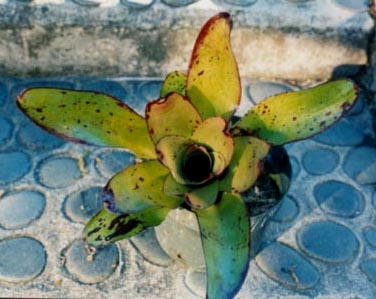A
catalogue of Bromeliads used for various projects by - © Lloyd Godman
This
is a catalogue of bromeliads used by Lloyd godman for his various installations
and photosynthesis projects - the collection of pants he accessed in
New Zealand from 1996 - 2004 was collected from a wide range of sources,
while most were brought from Greens Bromeliads, some were also donated
by the Dunedin Botanical Gardens. Later in 2004 these plants were either
sold or given away with his move to Australia.
Lloyd is at present re-establishing his collection where he now lives
in Melbourne.
A
Lexicon of Bromeliads: A
resource by Lloyd Godman
Neoregelias are quite hardy, among the easiest of Bromeliads to grow, and generally form open rosettes that dramatically change colour in the centre or heart at flowering. As these colour changes are usually in the maroon, red range they create striking combinations with the green leaves. The flowers are quite small and just protrude above the reservoir of water retained in the centre of the plant often with the down folding of the petals creating a meniscus that keeps the water from reaching the centre of the flower. While they grow best in average to warm conditions, (13-30 degrees C, 55-85 degrees F), some of the stiffer leafed varieties will stand temperatures lower than freezing.
Plants are marked NZ for those collected in New Zealand - or Aust - for the new plants collected since coming to Australia
| Neoregelia concentrica Var proserpine
|
|
|

.
|
Native distribution: Neoregelia concentrica is native to Brazil, where it grows in the cloud forests around Rio de Janeiro, Concentrica mostly grows on rocks that are exposed to some sun light, from sea level to 2,700 ft.
Habit: The wide leaves of this plant form a medium sized rosette similar to concentrica but larger. The olive green leaves are overlaid and edged maroon for about 2/3 of the way down from the top leaves
Flowers: At flowering time the centre becomes a shade of pomegranate purple
Cultivation: HARDY - In terms of light it can tolerate quite a lot of direct sun.
Fertilization:
|
|